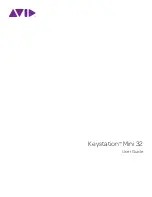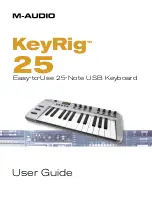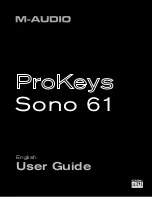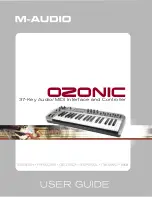
Section 2 — System•MIDI
ASR-10 Musician’s Manual
22
About Macros
Note:
All macro operations are performed with the Load button held down, and take effect when the
Load button is released.
Loading a Macro File
• Press Load then System•MIDI, and scroll to the macro file that you wish to load.
• Press Enter•Yes to load a new set of 28 macros into the ASR-10.
Creating a Macro
• Find the file or directory to which you want to assign a macro. Press and hold the Load button,
type any number from 1 to 28, while still holding Load, press Enter•Yes, then release Load.
The macro assignment will remain in effect until another macro file is loaded or the ASR-10 is
rebooted.
Invoking a Macro
• Press and hold the Load button, type and release the number of the desired macro. When you
release the Load button, the ASR-10 will go to the file that is assigned to the macro. If the file
is a directory, you will need to press Enter•Yes to actually enter the directory. If no file is
assigned to the macro, the macro number will be displayed, and nothing else will happen. In
MULTI and MONO B modes, incoming MIDI program changes 101-128 will invoke Macros 0-
27.
Saving a Macro File
• First, invoke macro 0 (zero) to get back to the proper directory for the currently loaded macro
file (macro 0 is a special macro that is always automatically assigned to the currently loaded
macro file and cannot be reassigned. It is used to allow you to easily get back to the directory
where the macro file that you last loaded is located. This makes saving your modified macro
files easier).
• Press Command, then System•MIDI, and scroll to the SAVE MACRO FILE command and
press Enter•Yes. The name of the current macro file will be displayed.
• The display will show FILE NAME = MACROFILE 1. If you want to create a new macro file,
edit the name of the file, and press Enter•Yes when you are ready. The new macro file will be
saved in the same directory as the old macro file(s).
• If you wish to update the old file, just press Enter•Yes. When the ASR-10 displays DELETE
OLD VERSION? press Enter•Yes only if you wish to replace the old macro file with the new
set of macros. This will save your newly defined set of macros into the macro file that was last
loaded.
You can have as many different macro files as you want by giving them different names. You
may also save them into any directory, although it is a good idea to save them in the root
directory so that they are easy to load when you boot up. Remember that macros can take you to
any file or directory, no matter how far down the file path. Also remember that you must resave
the macro file any time you add new macros and want them to be there the next time you boot
the ASR-10.
Tip:
A good example of the use of macros would be to assign macro 11 to a directory consisting solely
of bank files. Now, whenever you want to save your current group of instruments (and any
saved song file) as a bank, simply invoke macro 11 that selects your bank directory, and then use
the SAVE BANK command (press Command, then Instrument, and scroll to SAVE BANK). This
saves you from having to locate your bank directory each time. Another useful application of
macros is the transfer of files from floppy disks onto your SCSI Storage Device.
















































